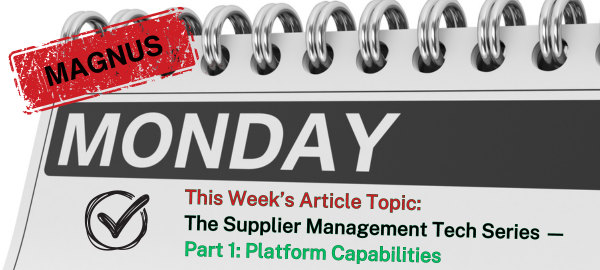Supplier management is a complex and critical activity for procurement organizations. A key problem is that many procurement professionals lack the tools needed to efficiently manage supplier relationships, information, performance, and risk. Ardent Partners research shows that less than a third of organizations have deployed supplier management solutions (around 30% compared to 40% for eSourcing, for example). There are reasons for that, one is that the ROI tends to be indirect and often hard to calculate, but also due to a fragmented and complicated solution market.
Over the next couple of weeks, I’m going to discuss the main areas of functionality when it comes to supplier management technology. In today’s article, I will start with some of the platform capabilities that are used across two or more of the functional areas. The functional areas, as Ardent Partners defines them, are Supplier Information Management (SIM), Supplier Performance Management, Supplier Risk Management, and Supplier Innovation and Development (SI&D). Each of these will be covered separately in the next couple of weeks.
Workflows
Workflow capabilities are critical for the overall usability of the solutions. Guiding different types of users (both buyers and suppliers) through the different processes and activities as easily as possible is necessary to drive adoption and usage.
Ideally, the solutions should offer a number of built-in best practice workflows but also support easy-to-use self-service creation of new workflows as well as editing and configuring of existing ones. To support more complex processes, conditional, bidirectional, and parallel workflows should be possible.
Data Model and Schema
Even though mostly pertinent to SIM, a flexible and extensible data model and schema is needed to truly support most aspects of supplier management. Since every organization and/or industry is different, the data models and schemas need to be configured to meet the use cases needed. And, of course, these use cases will change and evolve over time, not to mention all the new use cases that will be created.
Communication
Communication in the form of email, chats, notices, alerts, and so on are obviously another critical capability for any type of supplier management solution. Different types of communication methods are needed for the varied forms of messages and collaborations necessary to support overall supplier management. The solutions toned to communicate with single suppliers, specific groups of suppliers, or even all suppliers both synchronously and asynchronously.
Project & Campaign Management
For certain supplier management activities, project and campaign management support is needed. Examples include supplier onboarding campaigns or campaigns to collect additional data needed to meet new regulatory requirements. On the project management side, support is needed for everything from supplier development projects to new product launches to innovation projects.
Document Management
The ability to store, interpret, and extract data from various forms of document is another capability that supports numerous supplier management activities. Being able to extract data from meeting notes, annual reports, certificates, etc., and store it in useful formats can monitor compliance, kick-start initiatives, and automate massive amounts of manual data entry work.
Integrations and 3rd-Party Data
In today’s world of complex enterprise system architectures and third-party data providers, integration is more critical than ever. On one hand, you need to connect your supplier management solution(s) to your internal ERP, quality management systems, other procurement solutions, and likely a handful of other systems. These are systems that either need supplier information or hold information needed for supplier management purposes. On the other hand, there are many external third-party data providers that curate, aggregate, and sometimes create data and information you need to manage your suppliers.
A modern supplier management system needs to come with a number of pre-built connectors as well as supporting different integration methods for necessary custom integrations (APIs, IPaaS, etc.).
Analytics and Reporting
While this is a big topic, central to analytics and reporting is that you must be able to create reports and dashboards that show any data in your supplier management solution. You should also be able to do this on your own without needing to use the solution provider’s services or a consultant.
User and Access Management
Lastly, user and access management is a unique area in supplier management. In some cases, the supplier needs to manage its own users (to a limited extent of course). Given the complexity of supplier management, the supplier might need different users to manage core supplier data, innovation projects, or compliance information.
This wraps up the key capabilities needed across a holistic supplier management solution.
Next week, I will dive into Supplier Information Management. So stayed tuned. And, as always, if you have any questions, Ardent Partners is here to help!

